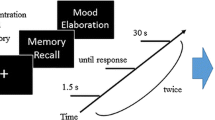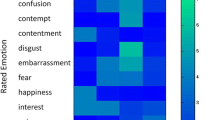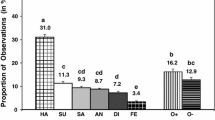Abstract
We measured facial behaviors shown by participants in a laboratory study in which a film was used to elicit intense emotions. Participants provided subjective reports of their emotions and their faces were recorded by a concealed camera. We did not find the coherence claimed by other authors (e.g., Rosenberg & Ekman, 1994) between the displayed facial expressions and subjective reports of emotion. We thus concluded that certain emotions are not a necessary or sufficient precondition of certain spontaneous expressions.
Similar content being viewed by others
References
Carroll, J. M., & Russell, J. A. (in press). Facial expressions in Hollywood's portrayal of emotion. Journal of Personality and Social Psychology.
Cornelius, R. R. (1996). The science of emotion: Research and tradition in the psychology of emotion. Upper Saddle River, NJ: Prentice Hall.
Dumas, G. (1923). Traité de psychologie (Vol. 1) [Handbook of psychology]. Paris: Alcan.
Ekman, P. (1972). Universals and cultural differences in facial expressions of emotion. In J. K. Cole (Ed.), Nebraska Symposium on Motivation, 1971 (vol. 19, pp. 207–283). Lincoln, NE: University of Nebraska Press.
Ekman, P. (1984). Expression and the nature of emotion. In K. R. Scherer & P. Ekman (Eds.), Approaches to emotion (pp. 319–343). Hillsdale, NJ: L. Erlbaum.
Ekman, P., Davidson, R. J., & Friesen, W. V. (1990). The Duchenne smile: Emotional expression and brain physiology II. Journal of Personality and Social Psychology, 58, 342–353.
Ekman, P., & Friesen, W. V. (1978). Facial Action Coding System (FACS): A technique for the measurement of facial action. Palo Alto, CA: Consulting Psychologists Press.
Ekman, P., Friesen, W. V., & Ancoli, S. (1980). Facial signs of emotional experience. Journal of Personality and Social Psychology, 39, 1125–1134.
Fernández-Dols, J. M., & Ruiz-Belda, M. A. (1995a). Are smiles a sign of happiness?: Gold medal winners at the Olympic Games. Journal of Personality and Social Psychology, 69, 1113–1119.
Fernández-Dols, J. M., & Ruiz-Belda, M. A. (1995b). Expression of emotion versus expressions of emotions: Everyday conceptions about spontaneous facial behavior. In J. A. Russell, J. M. Fernández-Dols, A. S. R. Manstead, & J. C. Wellenkamp (Eds.), Everyday conceptions of emotion. (pp. 505–522). Dordrecht, The Netherlands: Kluwer.
Fernández-Dols, J. M., & Ruiz-Belda, M. A. (in press). Spontaneous facial behavior during intense emotional episodes: Artistic truth and optical truth. In J. A. Russell & J. M. Fernández-Dols (Eds.), The psychology of facial expression. New York: Cambridge University Press.
Fridlund, A. J. (1991). Sociality of solitary smiling: Potentiation by an implicit audience. Journal of Personality and Social Psychology, 60, 229–240.
Fridlund, A. J. (1994). Human facial expression: An evolutionary view. San Diego, CA: Academic Press.
Friesen, W. V. (1972). Cultural differences in facial expressions in a social situation: An experimental test of the concept of display rules. Unpublished doctoral dissertation, University of California.
Gross, J. J., & Levenson, R. W. (1995). Emotion elicitation using films. Cognition and Emotion, 9, 87–108.
Hess, U., Banse, R., & Kappas, A. (1995). The intensity of facial expression is determined by underlying affective state and social situation. Journal of Personality and Social Psychology, 69, 280–288.
Hjortsjö, C. H. (1969). Man's face and mimic language. Lund, Sweden: Studentlitteratur.
Izard, C. E. (1994). Innate and universal facial expressions: Evidence from developmental and cross-cultural research. Psychological Bulletin, 115, 288–299.
Kraut, R. E., & Johnston, R. E. (1979). Social and emotional messages of smiling: An ethological approach. Journal of Personality and Social Psychology, 37, 1539–1553.
Landis, C. (1934). Emotion: II. The expressions of emotion. In C. Murchinson (Ed.), Handbook of General Experimental Psychology (pp. 312–351). Worcester, MA: Clark University Press.
Malatesta, C. Z., Fiore, M. J., & Messina, J. J. (1987). Affect, personality, and facial expressive characteristics of older people. Psychology and Aging, 2, 64–69.
Ortony, A. & Turner, T. J. (1990). What's basic about basic emotions? Psychological Review, 74, 315–341.
Patrick, C. J., Craig, K. D., & Prkachin, K. M. (1986). Observer judgments of acute pain: Facial action determinants. Journal of Personality and Social Psychology, 50, 1291–1298.
Philippot, P. (1993). Inducing and assessing differentiated emotion-feeling states in the laboratory. Cognition and Emotion, 7, 171–193.
Rosenberg, E. L., & Ekman, P. (1994). Coherence between expressive and experiential systems in emotion. Cognition and Emotion, 8, 201–229.
Ruch, W. (1993). Exhilaration and humor. In M. Lewis & J. M. Haviland (Eds.), Handbook of emotions (pp. 605–616). New York: The Guilford Press.
Russell, J. A., & Fernández-Dols, J. M. (in press). What does a facial expression mean? In J. A. Russell & J. M. Fernández-Dols (Eds.), The psychology of facial expression. New York: Cambridge University Press.
Sánchez, F., & Fernández-Dols, J. M. (1992). A study on spontaneous facial expressions. [Abstract] International Journal of Psychology, 27, 192–193.
Smith, C. A., & Scott, H. S. (in press). A componential approach to the meaning of facial expressions. In J. A. Russell & J. M. Fernández-Dols (Eds.), The psychology of facial expression. New York: Cambridge University Press.
Tan, E. S. (1996). Emotion and the structure of narrative film: Film as an emotion machine. Mahwah, NJ: Lawrence Erlbaum.
Wagner, H. L. (1990). The spontaneous facial expression of differential positive and negative emotions. Motivation and Emotion, 14, 27–43.
Author information
Authors and Affiliations
Rights and permissions
About this article
Cite this article
Fernández-Dols, JM., Sánchez, F., Carrera, P. et al. Are Spontaneous Expressions and Emotions Linked? an Experimental Test of Coherence. Journal of Nonverbal Behavior 21, 163–177 (1997). https://doi.org/10.1023/A:1024917530100
Issue Date:
DOI: https://doi.org/10.1023/A:1024917530100




